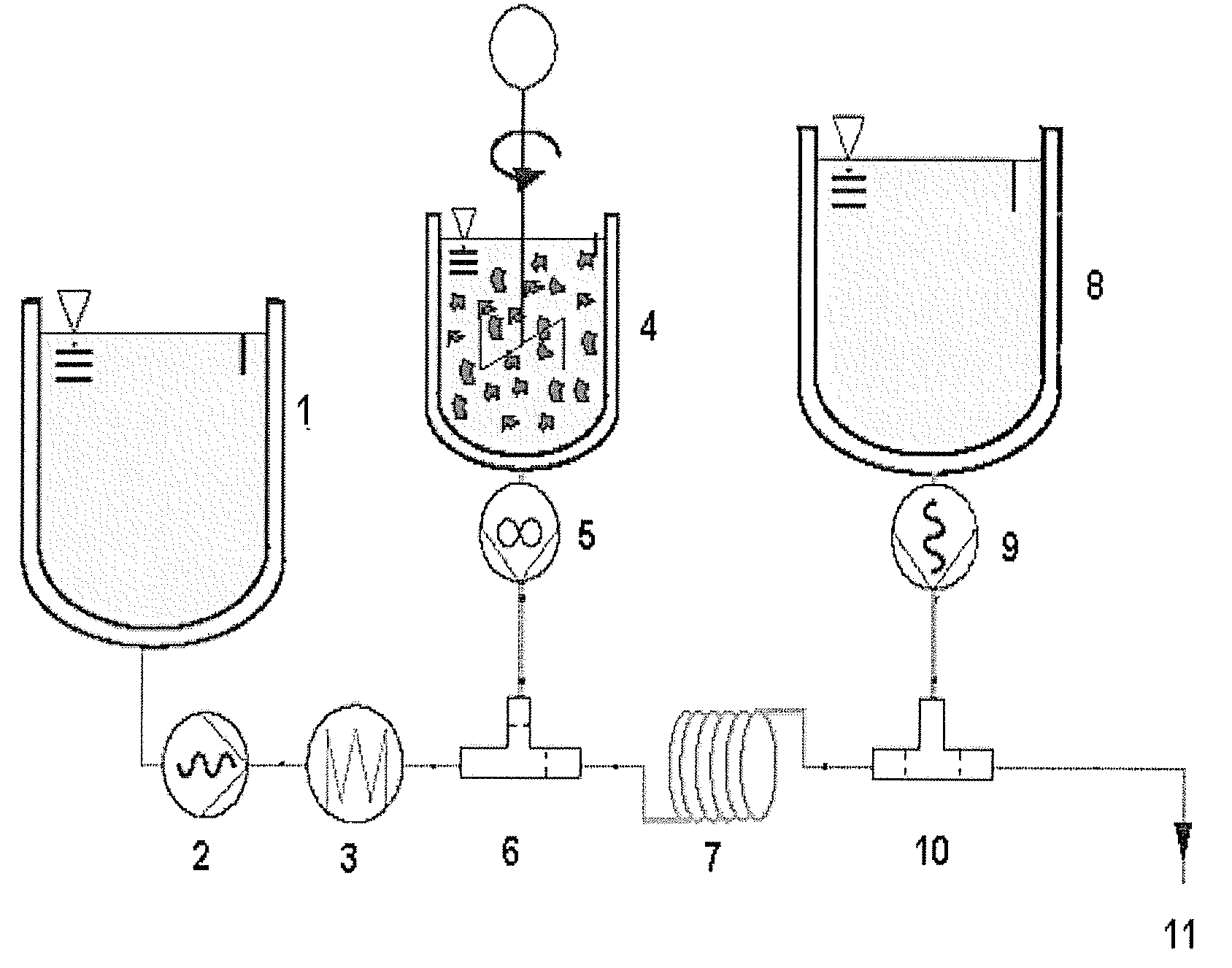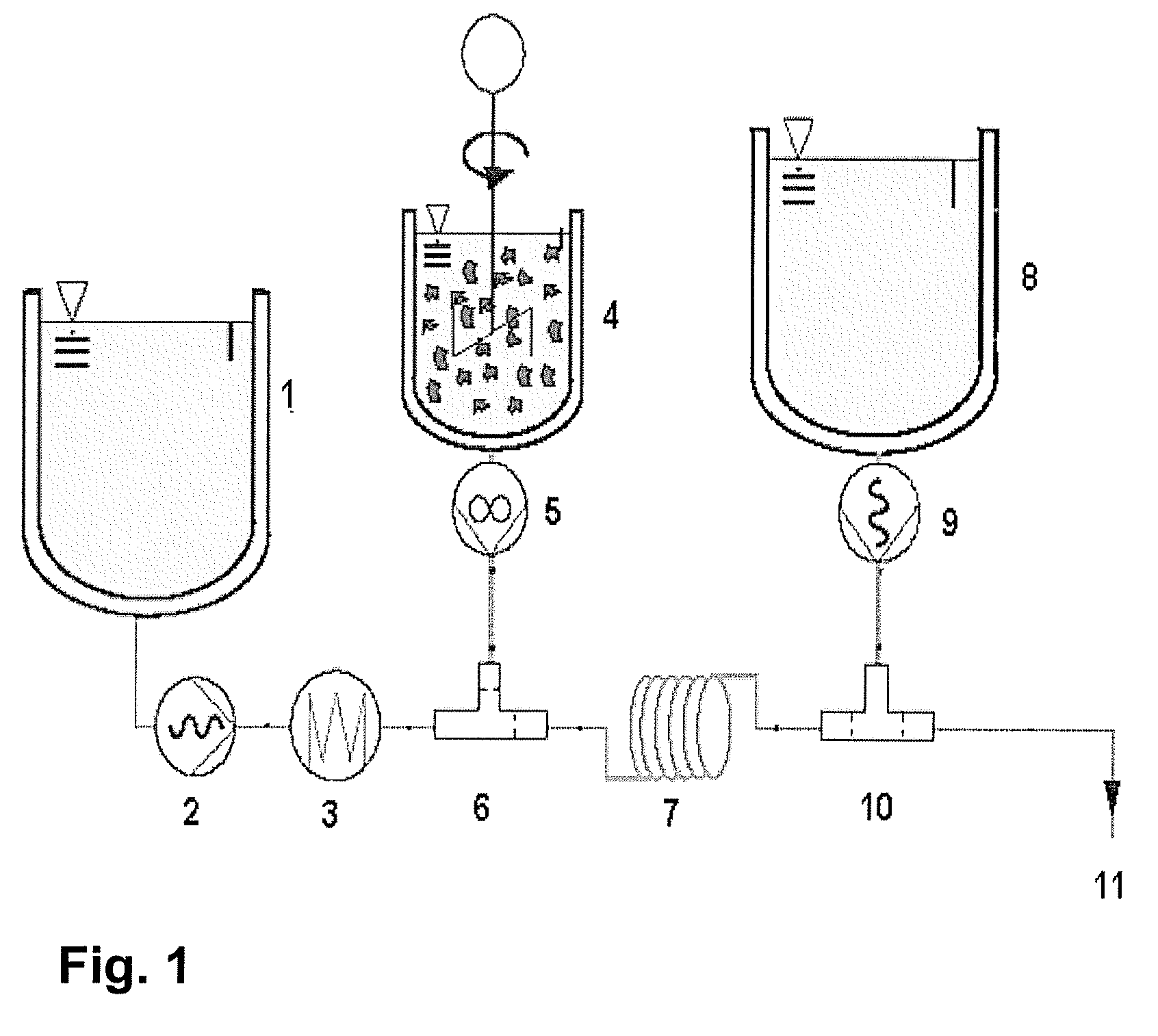Direct dissolution
a carotenoids and direct dissolution technology, applied in the field of continuous dissolution of carotenoids, can solve the problems of poor solubility, major hurdle in delivering carotenoids with good absorption and bioavailability
- Summary
- Abstract
- Description
- Claims
- Application Information
AI Technical Summary
Benefits of technology
Problems solved by technology
Method used
Image
Examples
example 1
[0084]100 g of crystals containing 80% (+ / −2%) synthetic all trans-astaxanthin with circa 20% by-products comprising cis astaxanthin, C-25 aldehyde astaxanthin, astacine and semiastacine are added to soya oil by using a precision engineered Silverson in-line rotor / stator mixer operating under such conditions that a 3000 ppm astaxanthin concentration is achieved. The in-line mixer is connected to a heat exchanger to heat the oil. In combination with the heat developed by the rotor stator the oil may be heated up to a temperature of 180° C. to 230° C. for 10 s. The resulting oily solution of astaxanthin is immediately mixed with a static mixer (Sulzer A G, Winterthur, C H) with a 10 fold excess of Manhedan fish oil heated at 40° C. The resulting oily solution is assayed for degree of dissolved astaxanthin and used for fish feed production.
example 2
[0085]Reference is made to FIG. 1.
[0086]Crystalline (98% pure), synthetic, astaxanthin is dispersed using 4% (w / w) in soya bean oil containing 4% (w / w) alpha-tocopherol at room temperature and subjected to a colloidal ball mill procedure performed at 70° C. to achieve a dispersion with the following particle size characteristics (measured with laser diffraction spectroscopy): d10: 1.0 μm, d50: 2.5 μm, d90: 6 μm. The suspension may be prepared separately and stored in a container for preparing an astaxanthin oil solution according to the method of the disclosure.
[0087]The suspension is diluted at room temperature with soya bean oil to achieve 1.5% (w / w, 15 000 ppm) astaxanthin and 1.5% alpha-tocopherol. 1 liter of the suspension at 23° C. is transferred to vessel 4 and gently stirred and pumped via mixing pump 5 at 1 kg / h through the mixing chamber 6, in which the astaxanthin suspension is mixed and heated with soy bean oil dosed from vessel 1 via pump 2 operating at 9 kg / h, previous...
example 3
[0090]In a manner analogous to Example 2, substantially pure, crystalline, synthetic, astaxanthin of Example 1 is dispersed using 10% (w / w) in soy bean oil containing 10% (w / w) alpha-tocopherol at room temperature. The suspension is subjected to a grinding in a colloid ball-mill at 70° C., to obtain a dispersion with the following particle size characteristics: 4.9%>5 μm, 95.1% between 2.7 and 1 μm (measured by fractionated filtration, followed by HPLC analysis of the astaxanthin content). The suspension is cooled to room temperature and diluted with soybean oil to achieve 1.5% (w / w) (15'000 ppm) astaxanthin and 1.5% alpha-tocopherol. One liter of the suspension at 23° C. is transferred to the vessel 4 and gently stirred and pumped via the mixing pump 5 at a rate of 1 kg / h through the mixing-chamber 6, wherein the astaxanthin suspension is mixed and heated with hot soy bean oil fed from the vessel 1 using the pump 2 operating at 9 kg / h, previously heated to 148° C. by passage throug...
PUM
 Login to View More
Login to View More Abstract
Description
Claims
Application Information
 Login to View More
Login to View More - R&D
- Intellectual Property
- Life Sciences
- Materials
- Tech Scout
- Unparalleled Data Quality
- Higher Quality Content
- 60% Fewer Hallucinations
Browse by: Latest US Patents, China's latest patents, Technical Efficacy Thesaurus, Application Domain, Technology Topic, Popular Technical Reports.
© 2025 PatSnap. All rights reserved.Legal|Privacy policy|Modern Slavery Act Transparency Statement|Sitemap|About US| Contact US: help@patsnap.com


